Asphalt Vs Concrete Paving: Key Comparisons and Advantages
Published on: August 8, 2025 | Last Updated: April 14, 2025
Written By: George Voss
Asphalt and concrete paving differ in materials, costs, and performance. Asphalt mixes crushed stone with bitumen (a petroleum binder), creating flexible surfaces priced at $2–$5 per square foot. Concrete combines cement, sand, and aggregates for rigid slabs costing $4–$10 per square foot. Asphalt resists cracks in freezing climates but requires sealcoating every 3–5 years. Concrete handles heavy loads better and lasts 30+ years with minimal upkeep. Asphalt recycling rates exceed 95%, while concrete production emits 8% of global CO2. Both offer varied textures and colors, but installation timelines and repair methods differ.
This article breaks down asphalt vs concrete across seven factors: material makeup, durability tests, cost differences (upfront and long-term), climate performance, maintenance needs, environmental impacts, and design flexibility. Learn how each handles heavy trucks, winter storms, or scorching heat. Compare repair costs for potholes vs cracked slabs. See which suits your budget, local weather, and style goals.
Contents
- Understanding Asphalt and Concrete Paving
- Material Differences: Asphalt Vs Concrete
- Durability Of Asphalt Vs Concrete
- Cost Comparison: Asphalt Vs Concrete Paving
- Installation Processes
- Maintenance Requirements
- Lifespan Of Asphalt Vs Concrete Surfaces
- Repair Methods for Asphalt Vs Concrete
- Environmental Impact Of Asphalt and Concrete
- Aesthetic Flexibility
- Pros and Cons Of Asphalt Vs Concrete
- Frequently Asked Questions (FAQs)
- Closing Thoughts
- Useful References for You:
Understanding Asphalt and Concrete Paving
Pavement materials shape road performance, cost, and maintenance needs. Let’s break down both options at the molecular level.
What is Asphalt Paving?
Asphalt combines crushed stone (95%) with bitumen binder (5%). This petroleum-based glue holds aggregates like limestone or gravel. Hot-mix asphalt gets laid at 300°F for driveways and roads, cooling into flexible surfaces. Modern mixes use polymer-modified binders rated PG 64-22 (Performance Grade) for temperature resistance.
- Contains recycled asphalt pavement (RAP) up to 30%
- Installation costs $2-$5 per square foot
- Cures in 24-48 hours for traffic use
What is Concrete Paving?
Concrete mixes Portland cement (10-15%), water, and aggregates like sand/gravel (60-75%). Steel reinforcement bars (rebar) or wire mesh boost load capacity. Fresh concrete gets poured into forms and vibrated to remove air pockets. Curing takes 7 days with spray-on sealants preventing rapid moisture loss.
- Compressive strength: 3,000-4,000 PSI
- Installation costs $4-$8 per square foot
- 28-day curing period for full hardening
With both materials defined, let’s analyze how their ingredients impact performance across roads, driveways, and parking lots.
Material Differences: Asphalt Vs Concrete
Distinct formulas define these two surfacing giants. Their chemical makeup drives performance in roads, driveways, and parking lots.
Asphalt Composition: Aggregates and Binder
Hot-mix asphalt contains 90-95% crushed stone/sand bonded with 5-10% bitumen. This petroleum-based glue coats aggregates at 300°F during mixing. Modern mixes use polymer-modified PG binders (Performance Graded) for temperature-specific durability. Recycled material makes up 20-30% of new mixes in most states.
Concrete Composition: Cement and Rigid Structure
Concrete mixes blend Portland cement (12-15%), water, sand, and coarse aggregates like gravel. Cement hydration triggers a chemical reaction – water molecules bind with calcium silicates to form rigid crystalline structures. Steel rebar or wire mesh reinforces slabs, while control joints manage cracking. Typical compressive strength ranges from 3,000-4,000 psi for driveways.
Bitumen’s flexibility lets asphalt flex under traffic loads without breaking. Cement’s crystalline matrix resists deformation but cracks under tension. These traits shape how each performs in freeze-thaw cycles or under truck traffic.
Up next: How these material properties impact longevity under weather extremes and heavy use.
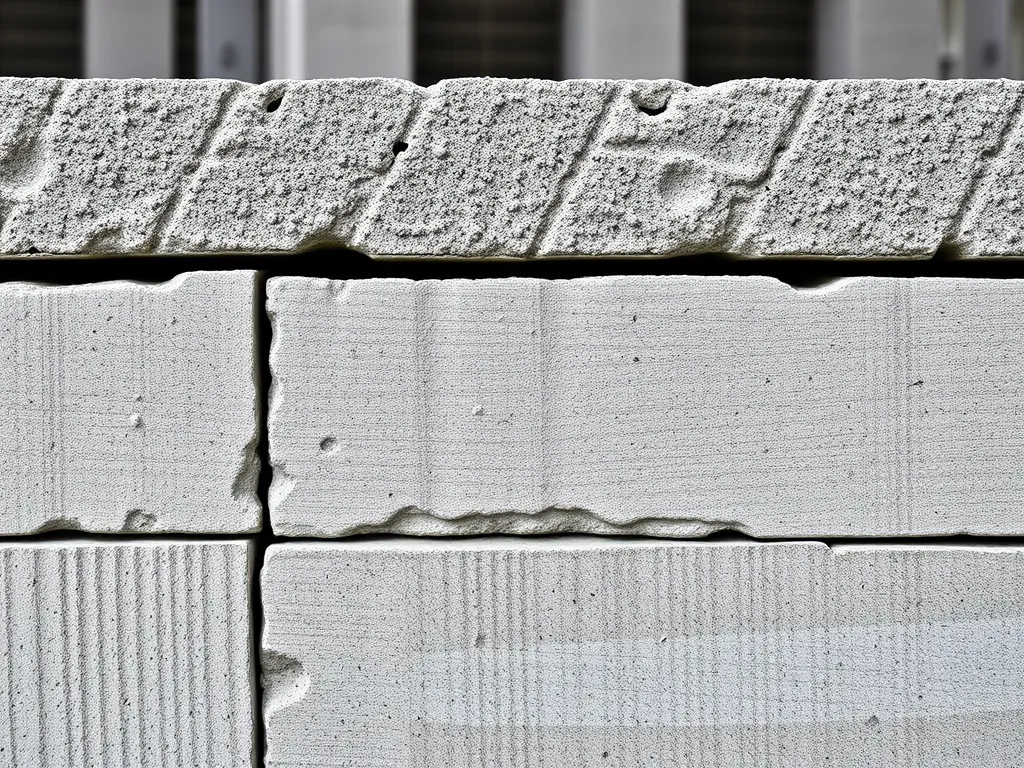
Durability Of Asphalt Vs Concrete
Durability shapes long-term value in paving. Both asphalt and concrete handle wear differently based on material traits.
Flexibility and Crack Resistance in Asphalt
Asphalt bends with ground shifts. Its 90-95% stone mix binds with sticky bitumen. This gives “flex strength” to absorb stress from frost heave or soil moves. Winter temps keep cracks small due to slow crack growth below 50°F. Sealcoating every 3-5 years blocks water seepage and UV damage.
Concrete’s Strength Under Heavy Loads
Concrete holds 3,000-4,000 PSI vs asphalt’s 300-700 PSI. Its rigid cement grid resists dents from truck weights or parked cars. Ideal for docks or bus lanes. But joints cut every 10-15 feet control where cracks form. Unreinforced slabs split under tree roots or soil dips.
Climate Performance: Freeze-thaw Resistance
Asphalt’s tiny air gaps let ice expand without surface breaks. PG-graded binders match local temps (e.g., PG 64-22 for Midwest winters). Concrete needs 5-8% air voids from admixtures to stop scaling. De-icing salts eat concrete faster unless sealed. Northern states see 20% more concrete repairs after harsh winters.
Durability ties to upkeep costs – a key factor when weighing asphalt vs concrete paving.
Also See: Asphalt Performance Assessment Methods: Quick Guide
Cost Comparison: Asphalt Vs Concrete Paving
Budget decisions between asphalt and concrete start with material costs but extend to maintenance cycles and environmental factors. Let’s break down the financial realities of both options.
Initial Installation Costs
Asphalt typically costs $2.50-$4.00 per square foot for driveways, while concrete ranges from $4.00-$6.00. Commercial projects like asphalt vs concrete parking lot installations see wider gaps: $3-$7 for asphalt versus $5-$10 for concrete. These prices cover materials, labor, and equipment like pavers or slipform machines.
| Project Type | Asphalt Cost/SF | Concrete Cost/SF |
|---|---|---|
| Residential Driveway | $2.50-$4.00 | $4.00-$6.00 |
| Commercial Parking Lot | $3.00-$7.00 | $5.00-$10.00 |
Long-term Maintenance Expenses
Asphalt demands more frequent care but lower individual costs. Sealcoating every 3-5 years ($0.14-$0.25/SF) and crack repairs ($1-$3/linear foot) add up over 20 years. Concrete requires fewer interventions but pricier fixes: slab replacements cost $5-$10/SF versus asphalt resurfacing at $1-$3/SF.
Factors Influencing Asphalt Vs Concrete Driveway Costs
Four key variables impact pricing:
- Climate: Asphalt’s flexibility suits freeze-thaw cycles better than rigid concrete
- Project Scale: Concrete becomes more cost-competitive above 5,000 SF
- Local Material Costs: Cement prices fluctuate more than asphalt binder
- Drainage Needs: Permeable concrete options add 10-20% to base costs
With cost factors clarified, the installation process determines how these materials perform over time.
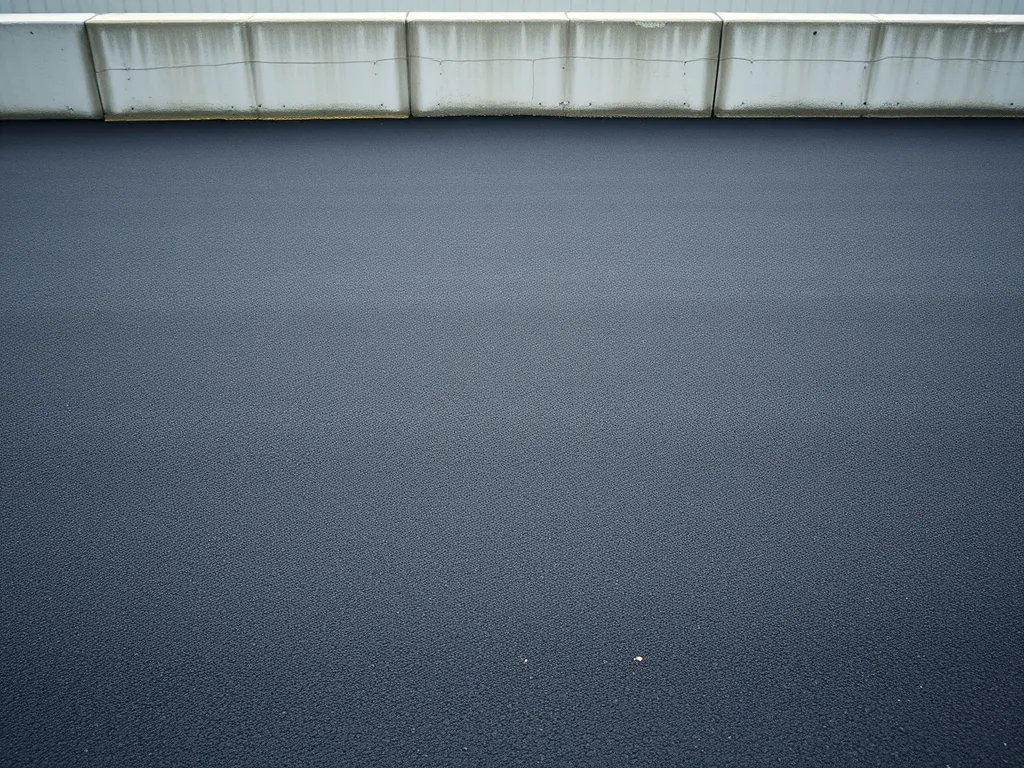
Installation Processes
Pavement installation separates asphalt from concrete through distinct methods. Each material demands specific techniques affecting project timelines, labor needs, and equipment choices.
Steps to Lay Asphalt Pavement
Asphalt crews start with 8-12 inches of graded aggregate base for drainage. A vibratory roller compacts the base to 95% density. Hot mix asphalt arrives at 300°F (149°C) from plants using PG 64-22 binders. Pavers spread the mix at 2-4 inch thickness while steel-wheel rollers achieve 92% compaction. Final rubber-tire rolling creates smooth surfaces ready for traffic within 24 hours.
| Phase | Timeframe | Key Equipment |
|---|---|---|
| Base Prep | 1-2 days | Motor grader |
| Asphalt Placement | 6-8 hours | Track paver |
| Compaction | 2-3 hours | 10-ton roller |
Steps to Pour Concrete Pavement
Concrete requires precise forming with steel-reinforced wood/metal frames. Crews place 6-8 inch thick slabs using 4,000 PSI mix containing 15% fly ash. Laser-guided screeds level the surface before bullfloating creates texture. Curing compounds get sprayed immediately after finishing – slabs gain strength for 7 days before joint sawing. Full load capacity reaches 28 days post-pour.
| Phase | Timeframe | Key Materials |
|---|---|---|
| Formwork | 1-3 days | #4 rebar |
| Pouring | 4-6 hours | Air-entrained concrete |
| Curing | 28 days | Membrane sealant |
Surface longevity depends on proper installation – but what happens after years of use? Next, we examine how upkeep needs differ between asphalt vs concrete surfaces.
Maintenance Requirements
Proper upkeep determines how well asphalt vs concrete paving performs over time. Each material demands specific care methods to address wear patterns and environmental damage.
Asphalt Maintenance: Sealcoating and Patching
Asphalt surfaces need sealcoating every 3-5 years using coal tar or asphalt emulsion. This $0.14-$0.25/sq ft treatment blocks UV rays and water penetration. Patching with hot mix asphalt repairs potholes and cracks – quick fixes costing $2-$5/sq ft versus full replacements. Driveways typically require crack filling annually to prevent freeze-thaw damage.
Concrete Maintenance: Joint Sealing and Slab Repairs
Concrete demands joint resealing every 2-5 years using silicone or polyurethane at $1.50-$3/linear foot. Unsealed joints let water erode the base layer. Slab repairs cost $8-$20/sq ft for mudjacking (lifting sunken sections) or full replacement. Parking lots often develop spalling – surface flaking from de-icing salts – needing grinding and resurfacing.
Both materials require different approaches to preserve their asphalt vs concrete surface performance over decades. Next, we’ll examine how these maintenance needs impact their total lifespans in real-world conditions.
Durability directly ties to how these surfaces age under traffic and weather stresses.
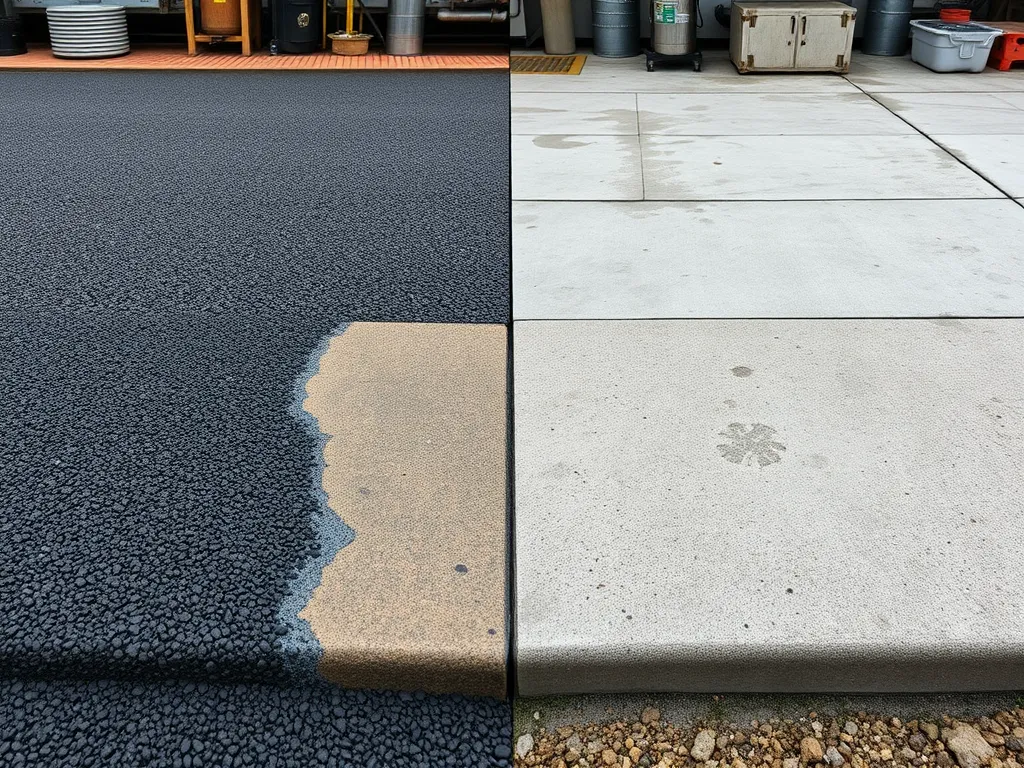
Lifespan Of Asphalt Vs Concrete Surfaces
How long each surface lasts shapes paving choices. Both need care but age differently under wear.
Typical Lifespan Of Asphalt Roads and Driveways
Asphalt lasts 15-20 years with care. Roads handle heavy trucks but crack faster in cold zones. Seal coats every 2-3 years block water and UV rays. Driveways stay smooth 12-15 years if sealed right. Costs drop 30% when reusing old layers in repairs.
Expected Longevity Of Concrete Parking Lots
Concrete holds 30-40 years with strong joints. Thick slabs (6-8 inches) handle trucks in lots. Salt and ice melt speed cracks in freeze zones. Saw-cut joints guide cracks away from slabs. Costs rise 20% for steel rebar but boost strength.
Surface care sets their pace. Next: how each material handles fixes when wear shows.
Repair Methods for Asphalt Vs Concrete
How you fix asphalt vs concrete surfaces depends on their unique weaknesses. Both materials need specific techniques to handle cracks, potholes, or structural failures.
Common Asphalt Repairs (Potholes, Resurfacing)
Asphalt repairs focus on flexibility and quick fixes. Cold patching fills potholes in 30 minutes using premixed asphalt concrete. For larger areas, infrared patching melts existing asphalt to bond new material seamlessly. Resurfacing adds a 1.5-2 inch overlay every 8-12 years to refresh worn surfaces at $1.50-$3.00 per square foot.
- Pothole patching: Costs $50-$300 per hole based on depth
- Crack sealing: Hot rubberized asphalt fills gaps up to 1 inch wide
- Resurfacing: Extends pavement life 10+ years without full replacement
Common Concrete Repairs (Crack Filling, Slab Replacement)
Concrete fixes demand rigidity and precision. Epoxy injections stabilize cracks under 0.25 inches. Full-depth slab replacement costs $8-$12 per square foot when joints fail or spalling exceeds 30% of the surface. Diamond grinding removes uneven spots at $1.50-$3.00 per square foot for parking lots.
- Partial-depth repair: Replaces top 2-4 inches of damaged concrete
- Mudjacking: Levels sunken slabs by pumping cement slurry underneath
- Stitching: Metal bars bridge cracks in load-bearing areas
Material choices shape repair timelines – asphalt fixes cure in hours, while concrete needs 3-7 days. Up next: How these materials impact ecosystems through recyclability and emissions.
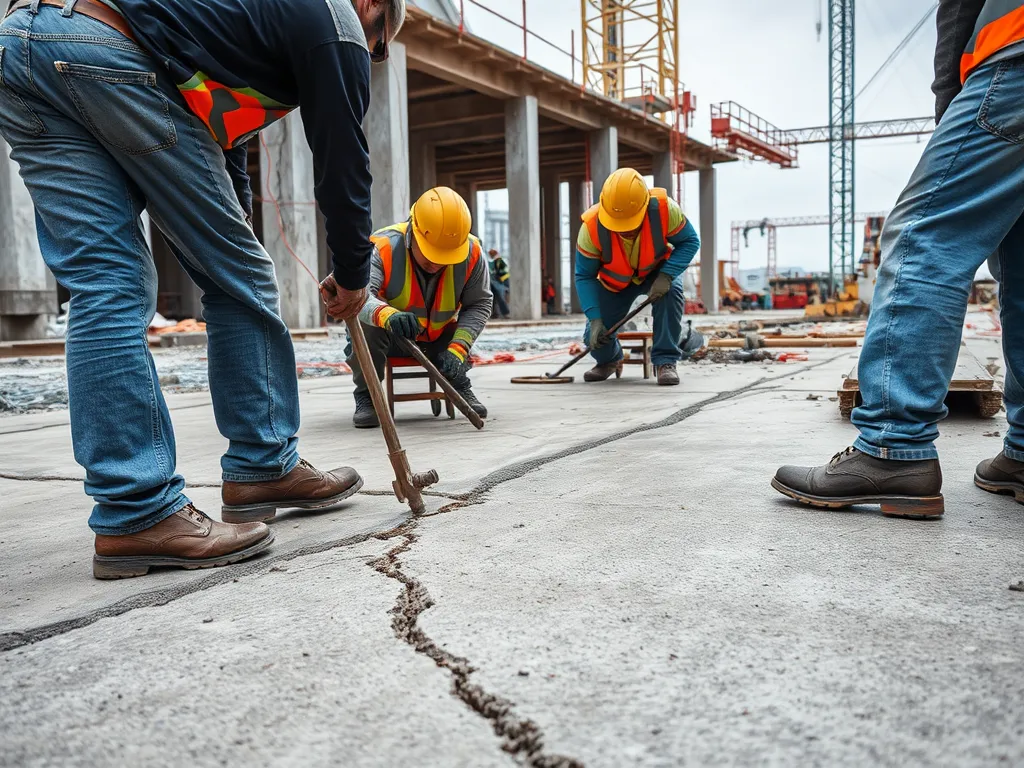
Environmental Impact Of Asphalt and Concrete
Both paving materials affect ecosystems and resource use differently. Let’s break down key factors shaping their environmental profiles.
Recyclability Of Asphalt Materials
Asphalt leads the pack with 95% recyclability rates. Old asphalt pavement gets crushed into RAP (Reclaimed Asphalt Pavement) for reuse in new mixes. Every ton of RAP used:
- Saves 2 barrels of oil
- Cuts material costs by $30-$50 per ton
- Reduces landfill waste by 1 cubic yard
Cold recycling techniques now allow roads to be rebuilt without heat – slashing energy use by 40% compared to traditional methods.
Carbon Footprint Of Concrete Production
Portland cement production accounts for 8% of global CO₂ emissions. Making 1 cubic yard of concrete:
- Releases 400-900 lbs of CO₂
- Consumes 4.7 million BTUs of energy
- Uses 10,000+ gallons of water
New SCMs (Supplementary Cementitious Materials) like fly ash help – replacing 30-50% of cement cuts emissions by 25%. Still, concrete’s 50-year carbon footprint remains 25% higher than asphalt’s when accounting for maintenance cycles.
When weighing surface options, visual appeal often tips the scale. Let’s explore design flexibility next.
Aesthetic Flexibility
Surface appearance plays a key role when selecting materials for driveways, parking lots, or roads. Both asphalt concrete and cement-based pavement offer distinct visual advantages depending on project goals.
Asphalt’s Smooth Finish and Color Options
Fresh asphalt pavement creates a jet-black surface with uniform texture due to its bitumen binder. While standard mixes deliver the classic dark gray hue, polymer-modified asphalt allows limited color customization. Contractors can blend iron oxide pigments (red, brown) or synthetic dyes (green, blue) into hot mix asphalt during production. Sealcoating every 2-3 years maintains color depth while protecting against UV fading.
Concrete’s Decorative Stamping and Staining
Cured concrete slabs serve as blank canvases for intricate designs. Contractors use stamping mats to imprint patterns resembling brick, slate, or cobblestone before the material fully sets. Acid staining creates marbled effects through chemical reactions ($3-$8 per sq ft), while integral pigments produce consistent hues like terracotta or charcoal. Exposed aggregate finishes reveal natural stone textures by washing away surface mortar. Decorative joints cut into slabs can mimic tile layouts for upscale driveways.
Both materials adapt to design needs – asphalt excels at sleek uniformity while concrete enables artistic customization. Up next: We break down how each performs under heavy use and harsh weather.
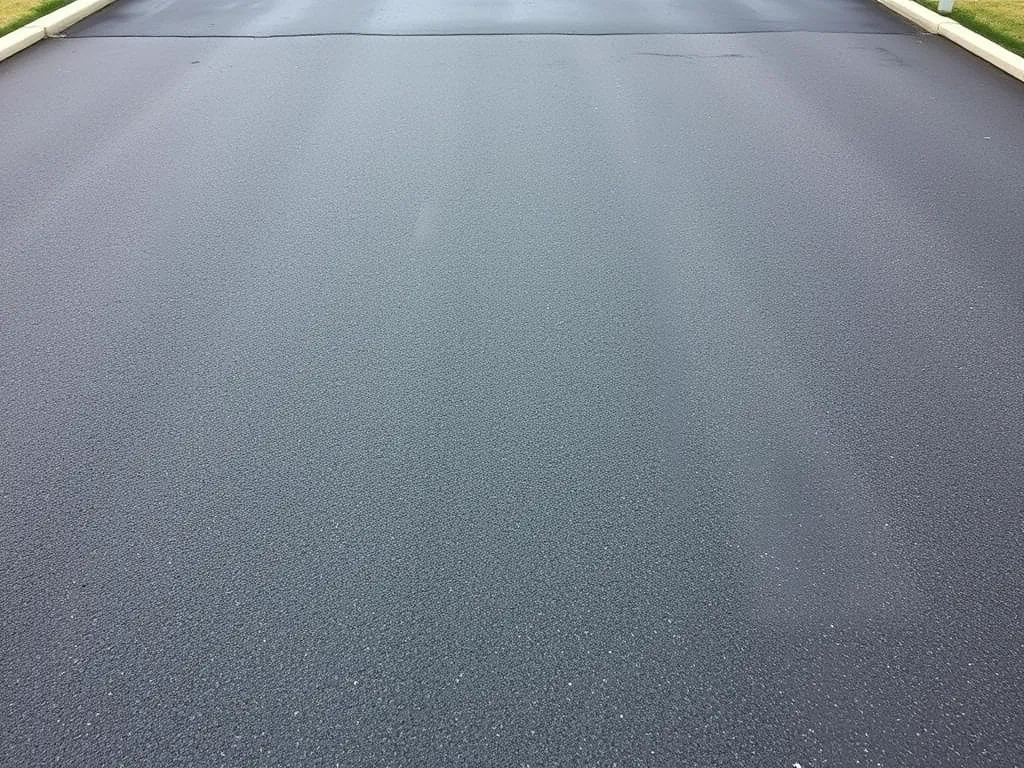
Pros and Cons Of Asphalt Vs Concrete
Both materials bring unique strengths to paving projects. Let’s break down their advantages and limitations across driveways, roads, and parking lots.
Benefits Of Asphalt Paving
Asphalt concrete delivers immediate cost savings at $2-$5 per square foot installed. Its flexible structure handles ground movement better than rigid slabs. Pavement crews can lay asphalt faster – most driveways cure in 24 hours versus concrete’s 7-day setting period. The black surface melts snow quicker in winter climates. With 95% recyclability rates, reclaimed asphalt pavement (RAP) reduces material costs by 30% in new mixes.
Drawbacks Of Asphalt
Asphalt vs concrete lifespan shows a clear gap: 15-20 years for asphalt versus 30-40 years for concrete. UV exposure causes fading, requiring sealcoating every 3-5 years ($0.15-$0.25 per sq ft). Summer heat can soften surfaces above 120°F, creating ruts under heavy trucks. Pothole repairs average $50-$300 depending on depth, with full resurfacing needed every 12-18 years.
Benefits Of Concrete Paving
Portland cement concrete boasts 3,000-4,000 psi compressive strength – triple asphalt’s load capacity. Its rigid structure resists deformation from semi-trucks in parking lots. Colored stains, stamped patterns, and exposed aggregates offer design flexibility. Minimal upkeep beyond joint resealing ($1-$3 per linear foot) makes it low-maintenance after curing. Concrete reflects 20-50% more sunlight than asphalt, reducing urban heat island effects.
Drawbacks Of Concrete
Concrete costs 40-60% more upfront at $4-$8 per square foot. Curing time delays project use by 5-7 days. Salt damage accelerates scaling in freeze-thaw cycles. Hairline cracks often spread without expansion joints, requiring $500-$1,000 slab replacements. Stain removal proves difficult on porous surfaces. Each ton of cement production releases 900 kg of CO₂ – a key environmental concern.
| Factor | Asphalt | Concrete |
|---|---|---|
| Installation Cost | $2-$5/sq ft | $4-$8/sq ft |
| Lifespan | 15-20 years | 30-40 years |
| Recyclability | 95% | 60-80% |
| Load Capacity | 1,500 psi | 3,000-4,000 psi |
Beyond initial savings versus long-term value, environmental impacts further complicate the asphalt vs concrete decision. Let’s examine sustainability factors…
Frequently Asked Questions (FAQs)
Is Asphalt Pavement Better Than Concrete?
The preference for asphalt or concrete pavement often depends on specific project needs, such as budget, climate, and expected traffic loads. Asphalt is generally favored for its lower initial costs and flexibility, while concrete is appreciated for its durability and longevity. Each material has its strengths and weaknesses that can suit different scenarios.
Is It Cheaper to Pour Concrete or Asphalt?
Asphalt is typically cheaper to install, with costs ranging from $2.50 to $4.00 per square foot, compared to concrete, which usually ranges from $4.00 to $6.00 per square foot. However, long-term maintenance costs should also be considered when determining overall expense.
What Are the Disadvantages Of Concrete Paving?
Concrete paving tends to have a higher initial cost, requires a longer curing time before it can be used, and is more susceptible to damage from de-icing salts in winter. Additionally, concrete can crack over time if not properly maintained, particularly without adequate expansion joints.
Which Lasts Longer: Asphalt or Concrete?
Concrete generally lasts longer than asphalt. Asphalt surfaces typically have a lifespan of 15-20 years, while concrete surfaces can last 30-40 years with proper care and maintenance.
Which is More Expensive to Repair—asphalt or Concrete?
Repair costs can vary significantly based on the type of damage and specific location. Generally, concrete repairs tend to be more expensive than asphalt repairs due to the need for more extensive techniques, such as slab replacement, which can range from $8 to $12 per square foot compared to asphalt pothole repairs, which typically range from $50 to $300 depending on the size of the damage.
Closing Thoughts
Choosing between asphalt and concrete paving hinges on various factors, including durability, cost, and environmental impact. Asphalt offers flexible, cost-effective solutions, while concrete stands firm with its strength and longevity. Consider your specific needs, from installation costs to maintenance requirements, when making a decision.
For a deeper dive into calculations and comparisons, check out Asphalt Calculator USA. We provide insightful resources to help you navigate your paving options effectively.
Useful References for You:
- The Asphalt Institute (Technical Resources & Standards)
- r/Concrete on Reddit: Would you recommend a concrete driveway or asphalt?
- Key Differences Between Asphalt and Concrete | K&E Flatwork
- Asphalt vs. Concrete Driveways: What Are the Differences and Which Is Right for You? | UNIQUE Paving Materials
- Concrete vs Asphalt: Which Makes a Better Driveway – Bob Vila


